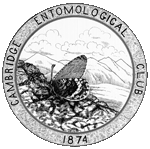
| January 2008: Psyche has a new publisher, Hindawi Publishing, and is accepting submissions |
Article beginning on page 41.
Psyche 15:41, 1908.
Full text (searchable PDF)
Durable link: http://psyche.entclub.org/15/15-041.html
The following unprocessed text is extracted from the PDF file, and is likely to be both incomplete and full of errors. Please consult the PDF file for the complete article.
COCKERELL - BEE-GENUS EXAERETE
NOTES ON THE BEE-GENUS EXAERETE.
BY T. D. A. COCKERELL, BOULDER, COLORADO. THE parasitic or inquilinous genus Exaerete Hoffmannsegg (C'hrysantheda Perty) is placed by Ashmead and other authors in the vicinity of Melissa, Mesocheira etc., these and many other genera forming a family Nomadidae. That these genera repre- sent several different stocks, is recognized by Ashmead himself (Trans. Amer. Ent. Soc., 1899, p. 65), and of all the discordant elements assigned to the "Nomadidae," the most discordant is Exaerete. The brilliantly colored bees of this genus were re- ferred by Fabricius, Latreille, Lamarck, and other early authors to Euglom, and this I believe was more nearly correct than their present position in the midst of the parasitic bees of Anthophorid stock. In structure and appearance they resemble EugZmsa, and especially the closely related genus Enfriesea,l in which the pubescence is rather scanty, the mouth parts are dark, and the scutellum has no patch of black tomentum. It is also to be noted that they are parasitic in the nests of Euglossa and its immediate allies (cf. Ducke, Zeits. fa wiss. Insektenbiol., 1906, p. 58.). It seems evident that Excerete is derived from the Euglossids, and is related to them as Psithyrm is to Bombus. Ashniead makes a distinct family, Psithzjridae, following Schmiedek- necht; but it seems better to recognize only a subfamily, Psithyrinae, for Psithyrus, and similarly to refer Exaerete to a subfamily Exaeretinae of the Euglossidae. The immediate occasion of these remarks was a specimen of Exaerete denfata (L.), received from the Museum of Comparative Zoology; the first member of the genus I had ever had occasion to study. I refer it to the Linnean dentata, but I find no really adequate description of that species, and it is not impossible that there are several forms in the great Amazonian region which would equally fit the Linnean diagnosis. The following particulars regarding the specimen before me may therefore be useful. Exaerete dentata (I,.)
9.
Length .(the head somewhat extended) about 174 mm.; entirely bright
green, with strong purple tints on thorax and abdomen in certain lights, the color exactly like that of Euglossa cordata townsendi Ckll. ; wings exceedingly dark fuligi- nous; mandibles and labrum without light marks; cheeks with short scanty white 1 Eufritsea n. n. = Eumorpha Frie~e, Term68 Fttzetek, 1899, p. 126 (not Httbner, 1806). Type Eufriesea pulchra (Eug'lossa pulchra Smith.). Pache 15:41-42 (l(108). hup //psyche emclub org/lS/lS-tMl.htniI
================================================================================
42 PSYCHE [April
hair above, and long glittering white hair below; long black hairs project from below the mandibles, some of them shining brilliant coppery-red in certain lights; clypeus densely punctured, the median keel feeble; clypeus and front with some purple lustre amid the green, but vertex behind the ocelli, and sides of mesothorax, shining golden- green; mesothorax with strong punctures on a shining ground, and with short pubes- cence, mixed black and dull white, only easily seen in lateral view; hair of pleura and metathorax dull white; scutellum with a strong shining boss on each side; punctures of scutellum very strong, except on the anterior middle, when they are small and very few on a smooth brilliant surface; no longitudinal groove or ridge on scutellum, and of course no little patch of black hair; tegulae very large, with dense small punctures; second r. 11. joining third s. m. a little before its end; legs with mostly light hair, but black bristles on basitarsi behind; outer face of hind tibiae coarsely tuberculate; abdomen shining, closely punctured, the punctures running together transversely; hair above pale, but very scanty, coarse black bristles beneath about apex; second dorsal segment with the apical margin broadly purple in the middle. The hind tibiae are convex without, and so coarsely punctured and cancellate as to be tuberculate. The broad hind basitarsus has a wide and rather deep groove, which is beset with yellowish hairs. On the middle of the hind femur beneath is a conspicuous tubercle. The second ventral segment is without any peculiar features. The labial palpi,. directed posteriorly, reach just beyond the middle of the hind coxae. Hob.- Teff e, Brazil (Raulin, Thayer Expedition). PROCEEDINGS OF THE CLUB.- At the Annual Meeting of the Cambridge Ento- mological Club, held in the rooms of the Appalachian Mountain Club on the evening of January 21, 1908, the following officers were elected: President, C. W. Johnson; Secretary, C. A. Frost; Treasurer, F. A. Sherriff; Members at Large of Executive Committee, J. H. Emerton, H. H. Newcomb; Editor in Chief of Psyche and Publica- tion Manager, W. L. W. Field. The retiring President, Mr. Newcomb, delivered a brief address in which he reviewed the recent progress of the science of entomology, and Mr. W. F. Fiske read a paper on "The Butterflies of Western Texas." At the regular February meeting, held in the same rooms on February 18, Miss E. N. Buckingham spoke on "Methods of keeping Ants and studying their habits," and exhibited various types of portable ant-nests and a convenient carrying-case.
================================================================================
Volume 15 table of contents